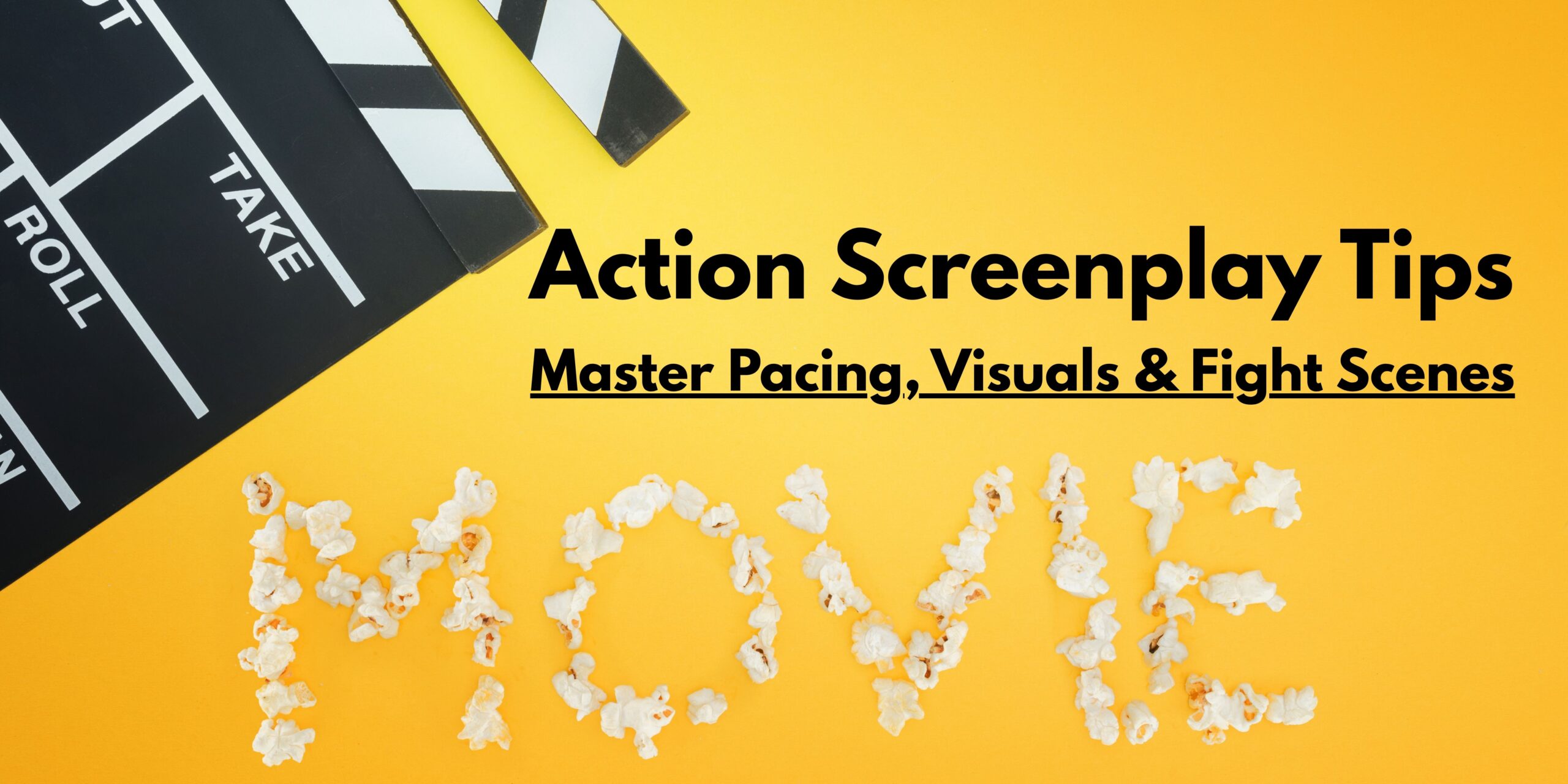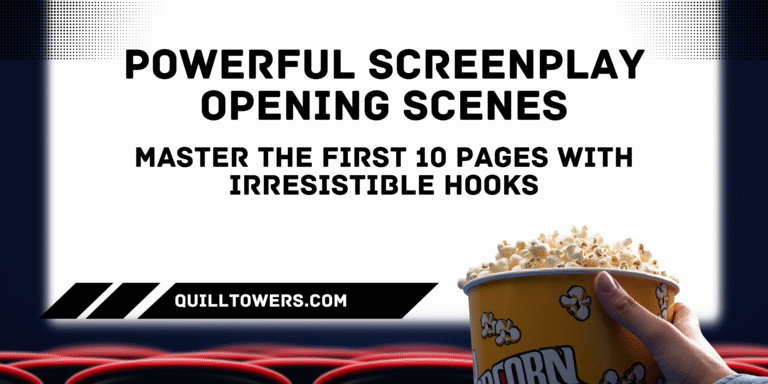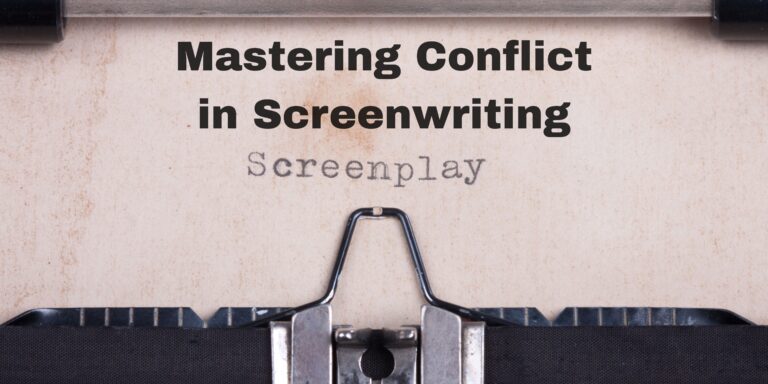Action Screenplay Tips: Master Pacing, Visuals & Fight Scenes
Every great action movie moves like a heartbeat, steady one moment, racing the next. From the first shot cracking past the hero’s ear to the showdown that leaves audiences breathless, pacing is the invisible force that keeps the story alive.
It’s what separates a gripping thriller from a boring movie with explosions.
In the world of action screenplay tips, pacing is your most valuable asset. It’s not just about running, chasing, or fighting; it’s about how fast your story breathes and when it takes a pause.
A well-paced script doesn’t just entertain; it manipulates emotion, builds anticipation, and keeps viewers hooked to the very last frame.
In this article, we’ll break down everything you need to master the craft of cinematic action writing, from structuring dynamic fight scenes and using rhythm-driven descriptions to crafting sharp visual beats that explode off the page.
Whether you’re choreographing your first brawl or refining a complex chase sequence, these techniques will help you write action that feels alive, looks realistic, and reads like film.
Strap in because the following few pages will show you how to make your action scenes hit like a punch to the gut.
Why Pacing Matters in Action Screenplay Tips
Every screenplay has a flow, and pacing keeps it alive. It’s the rhythm that dictates when your story sprints, strolls, or stops to catch its breath.
In filmmaking, this rhythm, known as narrative pacing, refers to the tempo at which your story unfolds. It’s what determines whether your film feels like a thrilling rollercoaster or a slow Sunday drive.
In simpler terms, pacing refers to the internal tempo of your story. Sometimes it races through high-octane moments; other times, it slows to let emotion sink in.
A well-paced script feels alive; it surges forward with energy but knows when to pause for impact.
Read more: How to Create a Compelling Character Arc That Drives Your Story Forward
When discussing action screenplay tips, pacing becomes the backbone of your storytelling. Action thrives on momentum, in that sense of “what happens next?”
A sluggish rhythm kills tension, while unrelenting speed leaves no room for connection, the secret lies in striking the perfect balance between explosive action and quiet revelation.
Remember:
- Pacing sets the tone for audience engagement.
- Fast isn’t always better; context matters.
- A slow moment can heighten suspense just as powerfully as a chase scene.
A well-paced action film feels effortless, even though it’s carefully engineered. Think of pacing as the speed control of your screenplay; you decide when to floor it and when to ease up.
Mastering this rhythm ensures your audience isn’t just watching the action; they’re feeling it.
Perfecting Script Pacing in Action Screenplay Tips
Controlling pacing starts where every great story begins, the script. Your screenplay is the blueprint of rhythm, the place where structure and timing first take shape.
In the realm of action screenplay tips, this is where you learn to fine-tune the beats that make or break your story’s flow.
One screenplay page typically lasts approximately one minute on screen. That’s not just trivia, it’s a tool.
Knowing how long each scene lasts helps you gauge when to accelerate and when to slow down. If your inciting incident lands on page 20 instead of page 10, your film might lose its spark before the fireworks begin.
Ask yourself:
- Does every scene advance the story?
- Are there moments that drag or repeat information?
- Do the emotional highs and lows feel deliberate?
Even long films like The Irishman or Once Upon a Time in Hollywood demonstrate that excellent pacing isn’t about speed, but rather about maintaining a steady rhythm. They breathe when they need to, sprint when it counts, and always keep the audience hooked.
To strengthen pacing, ground your script in solid story structure. Models like the Three-Act Structure, Hero’s Journey, or Story Circle give you a map for when key beats should land.
Plot structure tools can help you visualize this, allowing you to see whether your story’s energy builds, dips, or stalls.
However, remember that pacing doesn’t stop at the script. Unlike novels, films evolve through every phase:
- Pre-production: Adjust timing through storyboards and shot planning.
- Production: Directors and actors shape tempo through performance and blocking.
- Post-production: Editors become rhythm conductors, trimming or stretching scenes until the flow feels right.
The editing room is your final battlefield. It’s where the film finds its pulse again; scenes are cut, rearranged, or stretched to perfection. That’s why excellent pacing is a collaborative art form.
From the first draft to the final cut, every decision shapes the viewer’s experience. At its core, pacing is a form of emotional architecture. It’s about guiding the audience through chaos and calm, thrill and thought.
When honed, it transforms your screenplay from just another script into a cinematic experience that moves people, in every sense of the word.
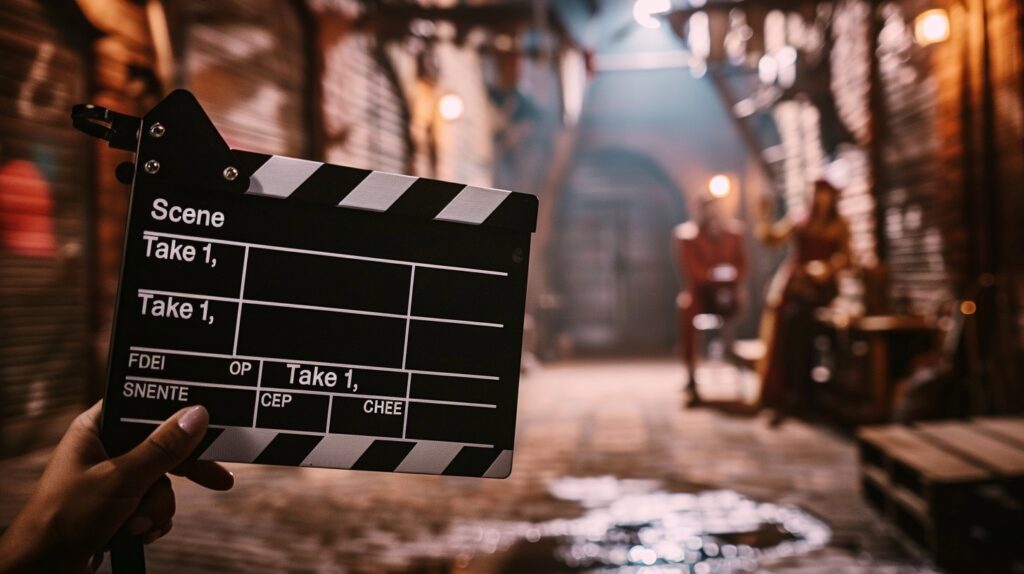
5 Layers of Pacing You Must Master in Action Screenplay Tips
If pacing powers your screenplay, these five layers are the fuel that keeps it alive. Many writers think good pacing means constant motion, nonstop action, crackling dialogue, or relentless suspense.
But excellent pacing isn’t about running at full speed; it’s about knowing when to race, when to breathe, and when to let the silence speak volumes. Screenwriting, like composing music, is built in layers, five to be exact.
Each layer adds rhythm and texture, giving your story depth and flow. Once you understand how they work, writing a well-paced screenplay becomes less like guesswork and more like fine-tuning an instrument.
Read more: Powerful Screenplay Opening Scenes: Master the First 10 Pages with Irresistible Hooks
Here’s a little Hollywood truth most won’t admit: when a script reader picks up your screenplay, they notice pacing before they notice plot.
A story can have a killer concept and compelling characters, but if the read feels sluggish, you’ve lost them before the second act.
On the flip side, a well-paced script, even with modest stakes, grabs attention from page one and holds it tight.
So yes, concept, story, and character matter, but pacing sells the experience. Let’s peel back the curtain and explore the five layers of pacing that can turn your screenplay into a masterclass in rhythm and storytelling.
Macro Pacing: The Big Picture Beat
Macro pacing refers to the screenplay’s architectural rhythm, which encompasses the overall flow from Act One to Act Three. It’s the bird’s-eye view of your story, where structure, setup, and payoff must harmonize like a well-scored symphony.
Picture this as the spine of your film. It’s what keeps everything upright and balanced. Tools like the Three-Act Structure, 15 Beat Sheet, or Story Circle help you plan your plot so that momentum builds naturally, not accidentally.
Here’s how to master it:
- Balance Your Acts: If Act One drags, your audience hasn’t even gotten on the ride. If Act Two bloats, they’ll start checking their watches. And if your finale wraps too fast, the emotional landing won’t stick.
- Vary the Energy: Every story needs a dance between intensity and intimacy. Give viewers space to breathe between explosions, and they’ll feel every impact twice as hard.
- Marry Plot and Emotion: Don’t let your action and emotion run on separate tracks. The most gripping films tie emotional stakes to physical conflict.
Think of Symphony No. 5 (Beethoven). That unforgettable opening wasn’t random; he experimented, restructured, and refined until every note was precisely where it should be. Your screenplay deserves the same rhythmic discipline.
Scene Pacing: The Flow Within the Frame
If macro pacing is your story’s spine, scene pacing is the muscle that moves it. Every scene should have purpose, precision, and pulse, no dead weight, no drift.
When it comes to action screenplay tips, this rule might as well be engraved on your keyboard:
Get in fast. Get out faster. Move the story forward.
Scene pacing is about rhythm within moments, how quickly a reader slips into a scene and how seamlessly they’re propelled into the next.
Envision it like a dance: every step matters, and lingering too long throws off the beat.
Scene Length: Cut the Fat, Keep the Flavor
You don’t need to show every footstep into a building or every dramatic exit into the sunset. Unless those details add tension, emotion, or reveal character, they’re just cinematic filler.
Ask yourself:
- Do we need to see the hero walk into the room? Usually not.
- Do we need to hear five pages of small talk before the plot moves? Definitely not.
- Does this moment teach the audience or the character something new? If not, cut it.
Every second on the page should serve a purpose. In the world of action screenplay tips, clarity beats clutter every time. Imagine your screenplay as an action sequence itself.
You don’t waste time watching the hero reload every bullet; you jump straight to the next move.
The same applies to pacing. Slice the fat, keep the flavor, and your story will stay lean and alive.
Scene Relevance: Purpose Over Padding
A scene without purpose is like a car revving in neutral, loud but going nowhere. Every scene should either:
- Advance the plot,
- Deepen a character, or
- Reveal something the audience didn’t know before.
Even comedic or quiet moments need to serve the story. A filler scene that exists only for a cheap laugh or shock might feel fun in the moment, but it weakens the story’s spine.
As you revise, ask:
“Does this scene earn its place in the script?”
If the answer’s no, hit delete with confidence. The beauty of a great screenplay is what you don’t include. Remember, tension thrives in restraint.
Scene Placement & Editing: The Invisible Hand of Rhythm
Here’s a secret weapon of action screenplay tips: learn from the editing room. Editing isn’t just post-production magic; it’s the rhythm of storytelling. Watch films similar to your script and pay attention to how editing shapes emotion and pace:
- Horror films build dread by stretching silence, then slicing it with sound.
- Comedies nail timing through quick setups and rapid-fire payoffs.
- Action movies keep the pulse racing by cutting at the peak of tension, not after it has passed.
Editing teaches pacing better than any screenwriting manual ever could. It shows you when to enter and exit a scene, how to build energy, and how to guide emotion.
Great editors are conductors, deciding when to crescendo and when to pause. In your screenplay, you are both composer and conductor. Control the tempo, and you control the reader’s heartbeat.
Beat Pacing
When it comes to action screenplay tips, beat pacing is the drive that keeps your story alive.
Every film breathes through its beats, those tiny moments of tension, decision, or revelation that propel the story forward.
Picture them as the rhythmic heartbeats of your screenplay: too fast, and your reader gasps for air; too slow, and the tale flatlines.
Read more: Electrifying Screenplay Plot Twist Techniques: Surprise Without Losing Your Audience
In screenwriting, beats aren’t random. They’re specific, deliberate, and measured, each one carefully spaced to keep momentum steady.
Uneven beats can lull your audience into disinterest, while erratic ones can jolt them out of the story entirely.
Great action writers know how to strike a balance between creating a rhythm that feels alive without ever becoming chaotic. Every genre dances to its own rhythm.
In dramas, beats often hinge on internal choices or discoveries; in action films, they’re fueled by external events, explosions, confrontations, and near-misses.
But whether your hero is dodging bullets or making life-altering decisions, each beat must serve one purpose: to move the story forward.
Between beats lie sequences, the connective tissue that links one dramatic moment to the next. A well-paced sequence acts like a steady drumbeat, building anticipation without exhausting your audience.
Each scene builds toward the next beat, carrying the story forward like a domino effect that doesn’t stop until the credits roll.
When you’re writing, ask yourself:
- Does this beat change something for the character or the audience?
- Does it lead naturally to the next moment?
- Does the rhythm of my story feel even and intentional?
Mastering beat pacing is one of the most overlooked yet crucial tips for action screenplays, as it’s what separates amateurs from professionals.
The pros understand that pacing isn’t just about how fast things happen; it’s about when and why they happen.
Get that right, and your screenplay will hum with the kind of energy that keeps readers turning pages deep into the night.
Sentence and Description Pacing: Say More with Less
One of the golden action screenplay tips that separates cinematic writing from cluttered storytelling is mastering sentence and description pacing. Remember this: screenplays aren’t novels.
You’re not painting with paragraphs, you’re sketching with strokes. Every word on the page must earn its place. The more ink you spill, the slower your reader moves.
Long descriptions stall momentum, while sharp, minimal writing keeps your story racing forward.
So, if you want to quicken your pacing, it’s time to trim the fat and write lean.
Here are three tools every screenwriter should keep in their toolkit:
Fragments: the minimalist’s weapon
Fragments are pure gold. They allow you to deliver a vivid image in just a few words. Think:
Dark and cold. Cold and wet. Hot and miserable.
See how fast your mind paints the picture?
Fragments cut through fluff and speak directly to the reader’s imagination. They make your screenplay feel immediate, alive.
Single-Sentence Blocks: one visual, one punch
Each block of description should deliver a single visual beat. Screenplays are, after all, visual stories.
The door bursts open. Smoke floods in. She doesn’t look back.
Short, sharp, cinematic. Each line hits like a frame in an action sequence.
Broad Strokes: suggest, don’t smother
Your job isn’t to describe every grain of sand. It’s to guide the reader’s focus. Broad strokes create space for the director and actors to fill in the details.
Instead of:
Rain poured down heavily as cars splashed through puddles and people rushed under umbrellas.
Try:
Rain hammers the street.
That’s it. One clean stroke, and your pacing surges forward. In the rhythm of action screenwriting, short sentences and fragments act like quick cuts in a fight scene, crisp, deliberate, and powerful.
Long paragraphs slow the camera down, but fragments pull the audience into the heat of the moment.
When in doubt, ask yourself:
- Can I say this faster?
- Does this sentence move the story or stall it?
Perfecting sentence and description pacing turns your screenplay from a slog into a sprint. It keeps readers hooked, producers impressed, and your story moving at the speed of cinema.
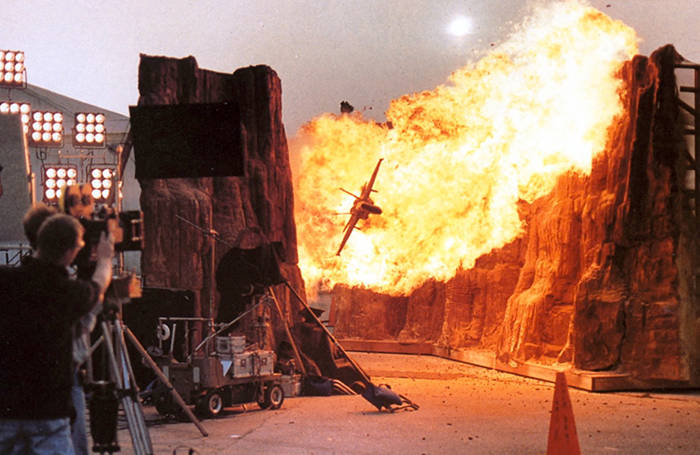
Transitions & Cuts Between Scenes: The Invisible Art of Momentum
Every action screenplay lives or dies by its rhythm, and nothing controls that rhythm quite like transitions.
These are the invisible bridges between your scenes, guiding your audience through time, emotion, and momentum without breaking immersion.
So, what exactly are screenplay transitions?
Imagine them as cinematic glue. They’re not just technical cues for editors; they’re storytelling tools that signal shifts in tone, perspective, or time.
From the classic CUT TO to the elegant DISSOLVE TO, transitions are the unsung heroes of pacing.
A Quick Look Back: Where Transitions Began
Before the sleek formatting of modern scripts, early filmmakers wrote scenarios, brief outlines of short films, in the early 1900s.
As stories evolved, those scenarios transformed into full-fledged screenplays.
Directors needed a way to guide editors between shots, birthing transitions like FADE IN, CUT TO, and DISSOLVE TO.
By the time cinema giants like Georges Méliès and Orson Welles were at work, transitions had become artistic statements.
They shaped how audiences felt time passing, how scenes collided or blended, and how meaning carried from one image to the next.
Honing Transitions in Modern Screenwriting
Today’s screenwriters don’t need to pepper their scripts with transitions on every page. The CUT TO is mostly implied between scenes.
But when used purposefully, transitions can elevate the cinematic rhythm of your script.
Let’s break down a few of the essentials:
- CUT TO:
The workhorse of transitions. Clean, fast, and invisible. Use it when you want to keep the energy moving or create a sharp emotional shift.
- DISSOLVE TO:
A visual fade from one scene into another, perfect for showing the passage of time or linking two moments with emotional continuity.
- FADE IN / FADE OUT:
The traditional bookends of your screenplay. FADE IN opens the story; FADE OUT closes it. Simple, timeless.
- FLASH CUT TO:
Blink and you’ll miss it, a lightning-fast shot used for shock, memory, or sudden impact. Ideal for action sequences or flashbacks of trauma.
- JUMP CUT TO:
A jarring leap forward in time or motion. Great for stylized storytelling or sequences that evoke a chaotic, fast-paced feel.
- MATCH CUT TO:
The artist’s favorite. It links two images by visual or thematic similarity, such as 2001: A Space Odyssey, where a bone thrown by an ape cuts seamlessly to a spaceship in orbit.
Each transition carries emotional weight. A DISSOLVE TO can feel nostalgic. A CUT TO can land like a punch. A MATCH CUT can turn symbolism into poetry.
The Golden Rule of Transitions
Use transitions with intent, not habit. Most modern readers expect them only when they add clarity or impact.
Think of them like musical beats; they’re strongest when they blend seamlessly into the score.
In the world of action screenwriting, mastering transitions means mastering tempo. Every cut, fade, or dissolve shapes how fast or slow your story breathes.
When you understand their rhythm, you don’t just write scenes, you conduct them.
SMASH CUT TO:
A Smash Cut is like a cinematic slap, sudden, sharp, and loaded with intent. It occurs when one scene abruptly transitions to another for emotional, narrative, or stylistic impact.
You might use it to:
- Transition from chaos to calm (or vice versa).
- Hide the immediate aftermath of a shocking event.
- Heighten suspense by letting the audience fill in the blanks.
Example:
In Vanilla Sky, we smash cut to a close-up of the lead character wearing a mask in his first appearance, following a flashback. The cut is jarring, unexpected, and perfectly mirrors the emotional dissonance of the moment.
The takeaway? Use Smash Cuts for surprise and emotional punch, not as a gimmick.
STOCK SHOT:
The Stock Shot is an older technique, primarily seen in historical or documentary-style films. It transitions to pre-existing footage, say, war reels, cityscapes, or natural disasters, to establish a setting or period.
Read more: Mastering Conflict in Screenwriting: Unleash Magnetic Screenplay Tension
While not common in modern screenplays, you might still use it if your story leans on archival imagery or a meta-narrative device.
TIME CUT:
A Time Cut is your friend when showing time progression in the exact location.
Imagine a lone figure marooned on a deserted beach:
- He screams into the wind,
- Silence,
- Days blur,
- His voice is gone.
Each shift in time is marked with a TIME CUT, signaling to readers (and viewers) that moments have passed, without spelling it out. It’s efficient storytelling through pacing and rhythm.
WIPE TO:
The wipe-to-transition, envisioning a curtain sliding across the screen, transitions from one scene to another.
George Lucas famously used this in Star Wars for stylistic flair, creating a signature old-school cinematic feel.
Today, it’s rare in scripts, but it can be used deliberately if you’re aiming for a nostalgic or stylized tone.
When (and When Not) to Use Transitions
Here’s the golden rule: less is more.
In the past, every scene change was preceded by a “CUT TO:”; however, modern formatting no longer requires it. Screenwriting software already implies a cut between scenes.
Overusing transitions can clutter your pages and break immersion.
Instead:
- Use SMASH CUTs, MATCH CUTS, and DISSOLVE TOs only when the transition serves the story.
- Avoid excessive technical direction; directors and editors have their own vision.
- Focus on readability and cinematic flow. Readers want a movie in their mind, not a lesson in film editing.
The Final Take
Transitions are spices, not the whole meal. Use them to enhance flavor, not overwhelm the dish.
A well-placed SMASH CUT can make a moment unforgettable. A subtle DISSOLVE can weave two emotions together. And sometimes, the best transition is none at all.
Write with cinematic intent, not technical overkill, because in the end, your goal is to make the story move.
Structuring Your Action Scenes with Proven Action Screenplay Tips
Action scenes are the beating heart of your screenplay, the moments that make audiences lean forward, grip their seats, and forget to breathe.
Whether it’s a high-speed chase, a tense standoff, or a brutal hand-to-hand fight, every great action sequence does more than dazzle; it drives the story forward and reveals character through motion.
To build those unforgettable, cinematic moments, you need structure, rhythm, and purpose.
Here’s how to shape your action scenes like a pro.
Build Every Scene Like a Mini-Story
Think of each action scene as a story within your story. It needs a beginning, middle, and end, a straightforward setup, a rising conflict, and a resolution that brings about a change by the end.
Every scene should:
- Establish setting, tone, and stakes.
- Create or escalate conflict.
- Advance the plot.
- Reveal something new about your characters.
In short, an action scene should do more than just show people punching each other; it should convey a meaningful message.
Ground Your Scene in POV and Setting
Readers visualize screenplays like movies playing in their heads, but they can’t picture what they don’t know.
Set the stage early:
- Where are we?
- When are we?
- Whose eyes are we seeing this through?
A brawl in a dark alley feels completely different from one in a neon-lit nightclub. Establish the setting quickly and concisely; there’s no need for lengthy paragraphs of description.
One or two vivid sensory details are enough to pull the reader in.
And don’t forget the point of view. If the last scene follows Joanna, but this one jumps to her rival, Martha, it signals a shift in the narrative.
Otherwise, your reader might experience a mental “record scratch” halfway through.
Give Your Protagonist a Clear, Immediate Goal
Every great action beat starts with a goal.
Ethan Hunt must defuse the bomb before the timer reaches zero.
Lara needs to leap the collapsing bridge.
Max needs to reach the cockpit before the plane nosedives.
Your POV character’s goal gives the sequence direction, and the obstacles you throw in their way provide it with shape.
Without that focus, even the most spectacular choreography will feel empty.
Throw Obstacles in the Way and Raise the Stakes
Conflict is oxygen for your story. Without it, your action scene suffocates.
Make your hero earn every step:
- The comms cut out mid-mission.
- Their ammo runs dry.
- The getaway car won’t start.
- Reinforcements arrive on the wrong side.
Each setback should push your character into a corner, forcing them to adapt, think more quickly, or break through their limits.
Remember: failure is fuel. The harder it is to win, the more satisfying victory feels.
Let the Characters Speak (Even in Chaos)
Yes, action scenes are about motion, but dialogue still matters.
A well-placed line can add emotion, tension, or humor.
Envision:
- The grim joke before pulling the final trigger.
- The desperate plea over a crackling radio.
- The breathless “I’m not leaving you!” as debris falls.
Avoid summarising dialogue (“They argued”); it kills immediacy. Let us hear them. Good dialogue gives the moment weight and humanity, even amid the explosions.
Keep It Cinematic and Tight
Screenplays aren’t novels. Keep your action fast, visual, and readable.
Use short sentences, fragments, and white space to control pace.
Instead of:
The car speeds down the alley, swerving past trash cans before crashing through a fence into the open road.
Try:
The engine roars.
Tires scream.
Metal tears through wood.
Freedom.
Each line should feel like a beat of film cutting in real time. The reader should see the action unfold shot by shot.
Putting Action on the Page
Even if your story isn’t packed with explosions or car chases, your screenplay still needs movement, physical, emotional, or psychological.
Action, at its core, is momentum.
It’s the heartbeat of every great scene, whether it’s a desperate sprint through a burning building or a quiet moment where a character makes a life-altering choice.
Let’s break down how to bring that heartbeat to life.
Put Action on the Page: Not Just in Your Head
Readers don’t want to hear about what’s happening; they want to see it unfold. That doesn’t mean every scene needs to feature gunfire or swordplay, but your characters should do things that matter.
They need to move, react, struggle, pursue, not just sit and think. If your protagonist spends the whole scene seated on a couch eating chips while scrolling on their phone, you’re not writing a story; you’re writing a still life.
Ask yourself:
- What is my character doing right now?
- Is their action bringing them closer to or further from their goal?
- Does this movement create friction, danger, or emotional tension?
If not, it’s time to get them off the couch.
Let Your Characters Feel the Action
Every punch, every chase, every desperate choice should leave a mark, not just on the body, but on the heart.
Don’t just tell us your character is sad, scared, or furious. Make us feel it with them.
Instead of:
Sarah was terrified.
Try:
Sarah’s breath hitched as the shadow crept closer, her fingers slipping on the trigger.
Pain, fear, joy, adrenaline, all these emotions fuel your actions.
Remember: if your character feels nothing, your audience will likely feel the same.
End Each Scene with Consequences
The most powerful scenes don’t just end; they change something.
Maybe the hero fails to stop the villain. Maybe they win, but at a cost. Maybe they uncover a truth that shifts everything.
Whatever the outcome, every scene should leave ripples that affect the next one.
If your character always succeeds, there’s no suspense. If they never face fallout, there’s no growth.
Raise the stakes, increase the tension, and make every choice matter. Because when readers can’t predict what happens next, they have to keep turning the page.
Balance Action with Reaction: The Power of Sequels
This is where Dwight V. Swain’s genius concept comes in. After the chaos of an action scene, you need a moment of stillness, a “sequel” where your character processes what just happened.
A sequel isn’t a new scene. It’s a pause.
It’s the breath between storms, the “Now what?” moment.
During this beat, your character:
- Reacts emotionally (shock, grief, fear, guilt).
- They think through their next move.
- Makes a decision that propels the next scene.
These reflective moments humanize your characters and deepen the emotional resonance of the story.
Without them, even the most explosive plot will feel hollow.
If scenes are the gas pedal, sequels are the brakes, and you need both to drive your story with control.
Know When to Break the Rules and When Not To
You don’t have to follow this structure every single time. In fact, creativity thrives in a controlled state of chaos.
Start a scene mid-action. Open with a single line of dialogue. Skip the calm and jump straight into the storm, as long as you know why you’re doing it.
But remember: readers sense confidence. They know when a writer is bending the rules for effect and when they’re breaking them out of confusion.
Structure isn’t a cage; it’s a safety net that lets you soar higher without falling apart.
Action Is Story in Motion
A story without action is a story standing still.
Your characters must move, feel, fail, and rise repeatedly. That’s what keeps readers invested.
So, make your characters bleed for their goals. Let their victories come at a price. Then, when the dust settles, give them a moment to feel the weight of what they’ve done before the next wave hits.
Because in the end, great action isn’t about chaos, it’s about consequence.
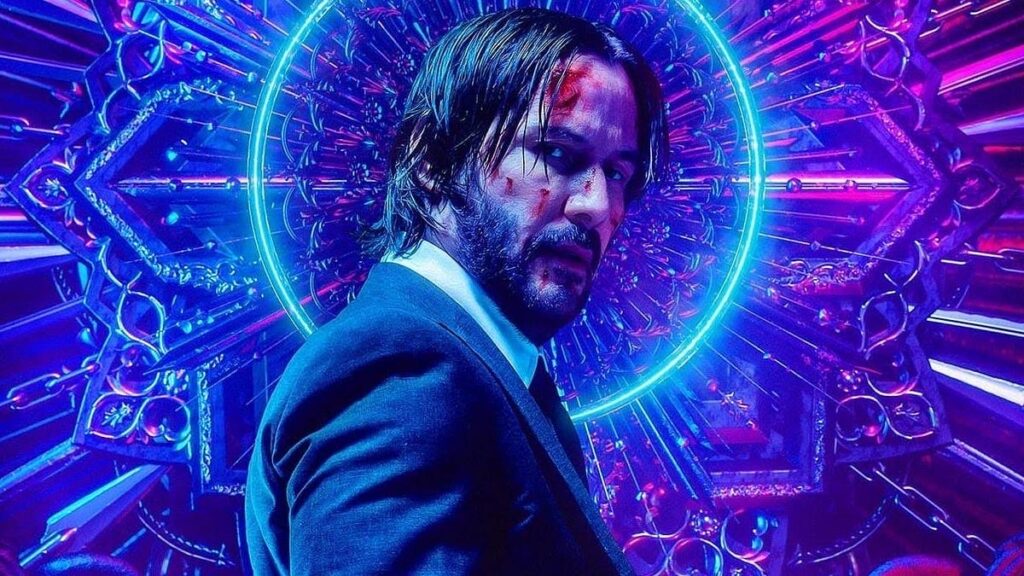
Writing Fight Sequences That Read Like Film: Essential Action Screenplay Tips
When you’re writing an action screenplay, fight scenes are where your story literally hits hardest.
They’re not just bursts of chaos; they’re a blend of choreography, emotion, and storytelling all rolled into one.
The best fight scenes aren’t about who punches harder; they’re about how each strike reveals character, advances the plot, and keeps the reader breathless.
To make your fight scenes leap off the page like a perfectly timed camera shot, here are five essential action screenplay tips that will turn your script into cinematic gold.
Make Rhythm Your Weapon
Every great fight scene has a cadence, a drive that pushes it forward like an ideally scored track.
That drive doesn’t come from fancy martial arts terminology or endless choreography; it comes from pacing, sentence structure, and timing.
Short, sharp lines quicken the tempo:
A punch. A kick. A block.
Longer sentences slow things down, which is useful when your characters are circling each other, calculating their next move.
Think of rhythm as your secret weapon. Read your fight scene aloud. Does it move like a movie?
Does it breathe like a boxer between rounds? That’s how you’ll know you’ve nailed the flow.
Cut the Fat: Keep It Cinematic
Fight scenes don’t need blow-by-blow accounts.
You’re not writing a martial arts manual, you’re writing a film.
The goal isn’t to describe every jab and uppercut, but to capture the highlights, the moments that matter to the story.
Trim anything that doesn’t reveal character, raise stakes, or shift momentum.
Good:
Glass shatters.
He lunges through the haze, desperate, wild.
One hit lands. It’s enough.
Bad:
He steps forward with his left leg, swings his arm in a straight line toward his opponent’s jaw, makes contact, then follows up with a knee strike to the ribs.
See the difference? One feels like cinema. The other feels like stage directions.
Your job is to make the reader see the fight, not track every move.
Focus on emotion and intent, not technique.
Think in Screen Minutes
Here’s the golden rule: one page = one minute of screen time.
That doesn’t mean every fight scene should take up five pages to feel “epic.” A good rule of thumb is to let the story dictate the length.
A quick scuffle might last half a page. A high-stakes showdown could span several pages, if every moment counts.
Use line breaks strategically.
Each return hit, each gasp, each moment of silence between strikes, that’s cinematic spacing.
When you structure your fight scenes with rhythm and white space, you’re not just writing; you’re directing on the page.
Make the Page Go Boom
Want to make an impact? Let the sound do the talking.
Onomatopoeia, words that sound like what they describe, is your shortcut to sensory storytelling.
Words like CRACK! SNAP! WHAM! Don’t just decorate the page; they make the reader hear the fight.
BOOM! The grenade hits the wall.
Dust rains down.
THUD! A body hits the floor.
Those moments of sound become emotional punctuation marks, like the beats in a film score.
Used sparingly, they make your action sequences explode in the reader’s imagination.
Remember: Action Serves Story
Every punch has purpose. Every hit should reveal something: fear, pride, desperation, or a sense of control.
A fight scene where nobody learns or changes is just noise. A fight scene that transforms your character? That’s cinema.
When your hero takes a blow, it’s not just physical, it’s emotional. Maybe they realize they’re not invincible.
Perhaps they will finally stop holding back. Maybe losing this fight sets up their most remarkable comeback.
The best action screenplays don’t just show violence; they use it to tell the truth about their characters.
Let the Reader Feel Every Hit
Your fight scenes shouldn’t read like instruction manuals; they should read like movies playing in real time.
Keep the rhythm tight. Focus on story, not spectacle. Use white space, sound, and emotion to make every moment land with impact.
When you do that, your reader won’t just read about your action scenes; they’ll see, hear, and feel them.
That’s how you write fight sequences that hit as hard on the page as they do on screen.
Make the Page Go Boom (and Buzz, Crack, or Slam)
Action isn’t just visual, it’s auditory. Every punch, crash, and shatter carries weight when the reader can hear it in their head.
That’s where sound cues come in.
Here are some of the most effective fight scene sound cues to punctuate your action lines:
BANG. BOOM. BONG. BUZZ. CRACK. CRUNCH. DING. GRIND. GURGLE. HISSSS. POP. SLAM. SLICE. SMACK. SNAP. SPLASH. SPLATTER. THWACK.
Each sound has a personality: CRACK is sharp and sudden, GRIND feels gritty and drawn out, GURGLE is visceral and unsettling.
Use them like percussion in your scene.
You don’t need to fill the page with sound effects; one well-placed cue can be more powerful than a paragraph of description.
THWACK! The bat connects with the doorframe.
CRUNCH. Wood splinters underfoot.
HISSSS… the gas ignites, filling the room with heat.
Sound cues do more than describe; they cut through the noise. They give rhythm, texture, and immediacy to your writing, making the reader feel the hits as if they were in the scene themselves.
Ellipses for Impact
Now that you’ve got rhythm and sound working together, let’s add another subtle weapon: the ellipsis (…).
An ellipsis is three dots that…
Slow time.
They let you hang on a beat, draw out tension, or create anticipation before the next explosive moment.
Film producers and directors aren’t grammar purists; they care about rhythm, pacing, and how the story plays. That’s why ellipses are a screenwriter’s secret rhythm tool.
You can use them to split a meaningful action beat across lines for cinematic effect:
He leaps across the railing…
…landing hard on the enemy.
Or to combine with sound cues to hit even harder:
The bomb ticks…
BOOM!
The pause builds suspense. The follow-up delivers impact. Together, they mimic the edit cuts and beats of the film itself.
So don’t be afraid to use ellipses strategically to slow, heighten, or punctuate, just don’t overdo it.
Like a perfect punch, it only works when it lands at the right time.
Avoiding Pacing Pitfalls with Action Screenplay Tips
Even a great story can stall if your screenplay is bogged down in excess detail, exposition, or flat moments.
The trick is knowing what to show, when to show it, and when to let silence or action carry the weight.
Here’s how to steer clear of pacing killers:
- Slash the Fluff
- Too much information slows momentum. Readers don’t need every detail; they just need what moves the story forward.
Bad:
Jonathan had been an insomniac since his teenage years, constantly tossing and turning at night, plagued by memories of his parents’ divorce, the bullying he endured in high school, and the endless pressure to succeed in college.
Good:
Jonathan’s eyes are bloodshot. His desk lamp burns at 3 a.m. Coffee cups crowd the keyboard.
One sharp image beats a whole backstory dump.
- Drip, Don’t Dump
- Screenplays aren’t history lessons. Don’t dump everything at once.
Bad:
The company was founded in the 1970s by Harold Whitman, who built it from scratch after the oil boom. Over the years, it expanded into five divisions, eventually dominating the skyline with its headquarters.
Good:
The building’s bronze plaque reads: Whitman Industries, Est. 1973. A receptionist types beneath a portrait of Harold Whitman, cigar frozen mid-smile.
Let setting clues slip in naturally.
- One Detail Beats Ten
- A catalogue of features doesn’t reveal character.
Bad:
Sophie had curly black hair, wore round glasses, a red scarf, scuffed boots, and carried a large leather satchel stuffed with papers. She was short, with freckles on her nose, and always chewed on her lip when she was nervous.
Good:
Sophie adjusts her glasses with ink-stained fingers, a walking secret she hasn’t decided whether to share. One detail that ties to personality is better than ten random ones.
- Jump Past the Ordinary
- Daily routines kill pacing.
Bad:
Ethan brushed his teeth, buttoned his shirt, tied his shoes, grabbed his keys, and walked out the door.
Good:
Ethan burst into the meeting, shirt half-tucked, toothpaste still stinging his tongue.
Jump straight to tension.
- Trim the Filler Talk
- Not every “hello” belongs in your script.
Bad:
- “Hey.”
- “Hi.”
- “How are you?”
- “Fine. You?”
Good:
“Hey, you’re late again.”
“Yeah, and you’re sober, for once.”
Instant conflict, instant character.
- Sketch, Don’t Smother
- Don’t bury the scene under blueprints.
Bad:
- The diner had red leather booths along both walls, each separated by metal dividers. The floor was black-and-white checkered tile, and a long counter with chrome stools ran parallel to the booths. Behind the counter were coffee pots, a pie display, and a neon sign that blinked “OPEN.”
Good:
Grease hisses on the grill. A neon “OPEN” flickers above empty booths. The smell of burnt coffee hangs heavy.
Suggest, don’t suffocate.
A screenplay should breathe, quick strokes of detail, sharp bursts of dialogue, and action that matters.
Too much information, overwritten description, or aimless chatter stalls pacing. Keep it lean, keep it moving, and let the camera do the heavy lifting.
Turning Action Into Art
Every great action screenplay thrives on rhythm, restraint, and reaction. Whether you’re crafting a brawl in a back alley or a car chase through neon-lit streets, the same rules apply:
- Keep the rhythm sharp. Let every line pulse with momentum.
- Cut the fat. Focus on clarity, not choreography.
- Think in screen minutes. Let pacing guide your edits.
- Make the page go boom. Use sound and space to immerse your reader.
- Embrace emotion. Even the fiercest fights land harder when they reveal character.
- Balance the beats. Action breathes best when sequenced with reflection.
Master these principles, and your script won’t just read like a film; it’ll feel like one.
Let’s Turn Your Vision into Motion
At Quilltowers, we don’t just write, we ignite stories.
Our team of screenwriters and content architects know how to balance rhythm, pacing, and emotional impact to bring your action sequences (and your entire script) to life.
Can your screenplay feel like a film before it hits the screen?
With Quilltowers by your side, it will. Let’s bring your story to life, one explosive beat at a time.
Contact us today!
